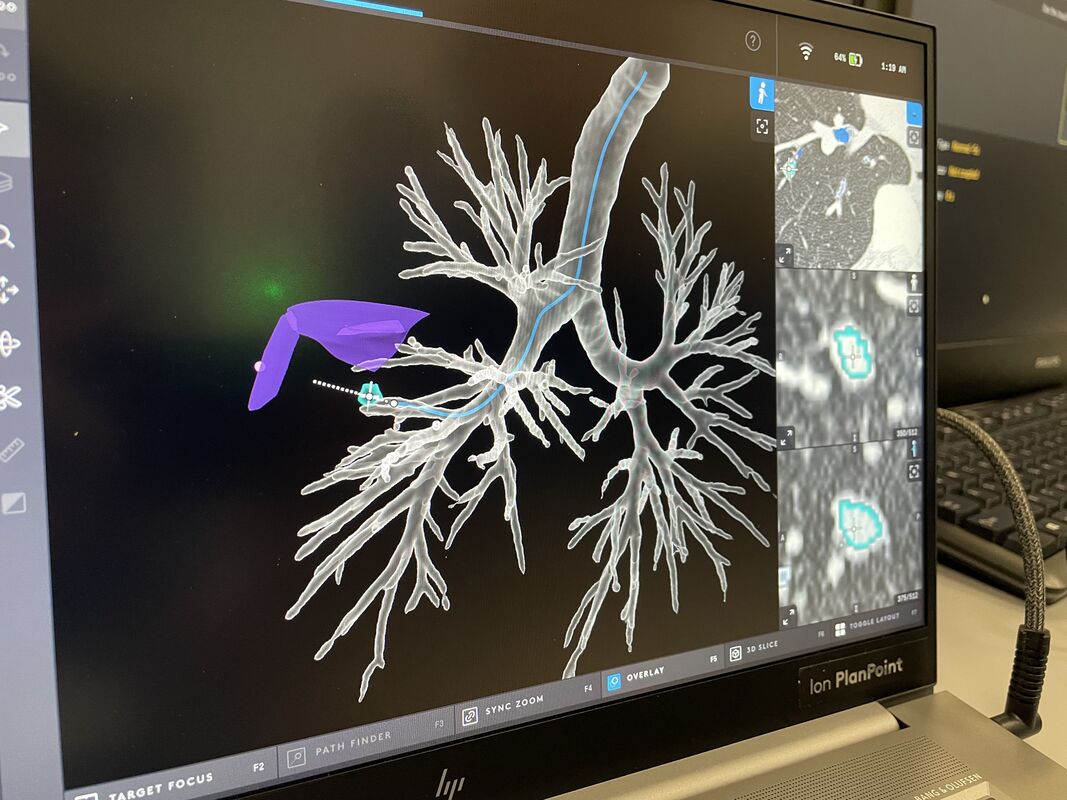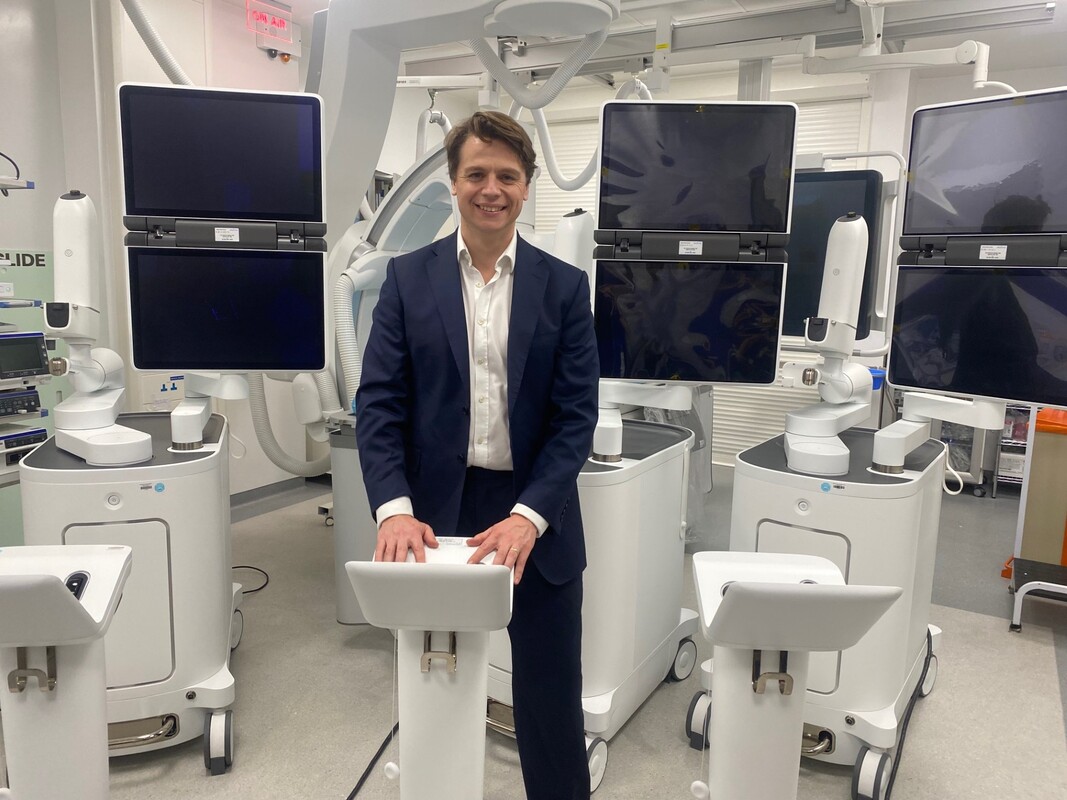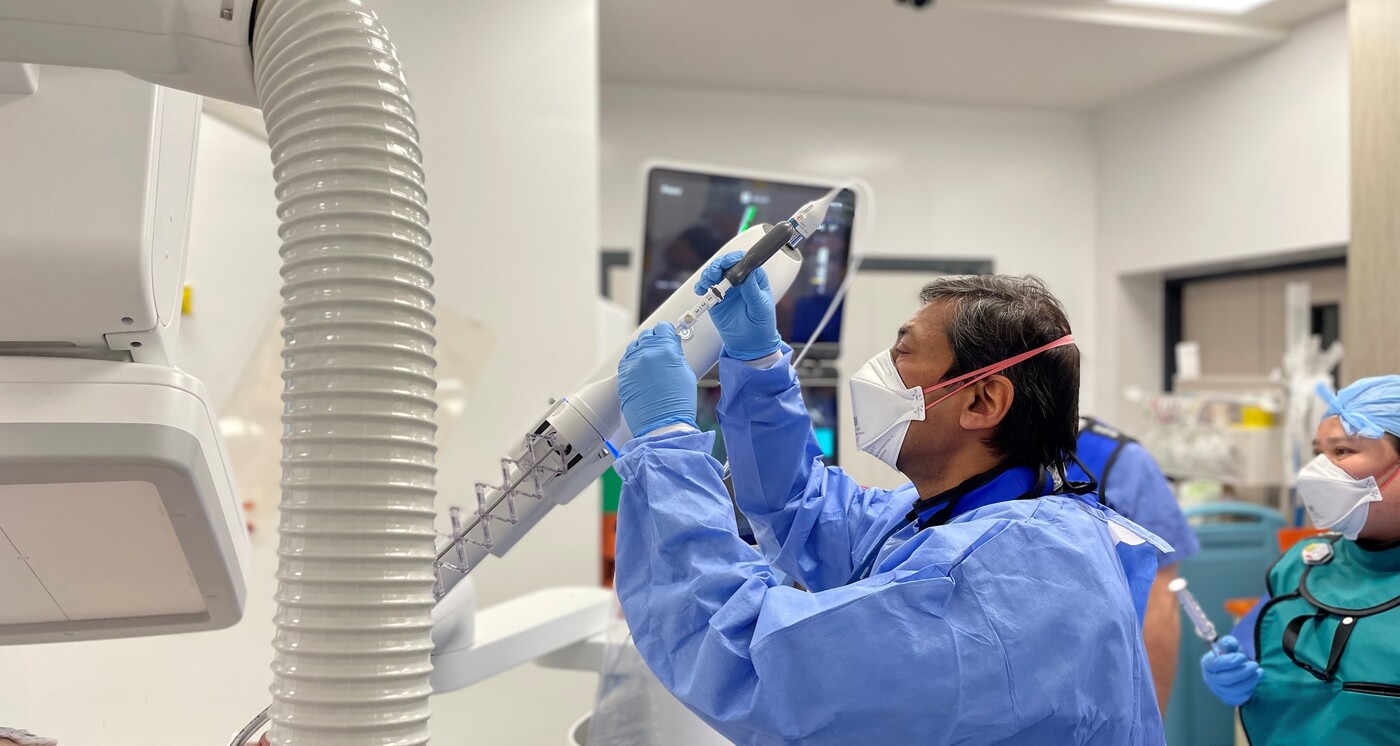A new robotic-assisted technology, used for the first time in the UK by our team at Royal Brompton Hospital, allows specialists to take biopsies of very small lung tumours which would otherwise be difficult to reach. The Ion endoluminal system (Ion) means that lung cancer can potentially be diagnosed earlier, when the likelihood of survival is highest.
Lung cancer often detected too late
Almost 50,000 people are diagnosed with lung cancer each year in the UK, making it the third most common type of cancer and the leading cause of cancer death. It is often difficult to identify and therefore over two-thirds of cases are diagnosed late, at an advanced stage of progression.
The outlook for lung cancer is typically worse than that of other types of cancer, with 60% of patients dying within the first year of their diagnosis. Current treatment options for lung cancer include surgery, chemotherapy and radiation therapy, but the factor that increases the chance of survival more than anything else is early diagnosis.
Professor Pallav Shah, consultant physician in respiratory medicine at Royal Brompton and Harefield hospitals, and Dr Christopher Orton, consultant in respiratory medicine, worked on the Ion Robot trials to achieve early diagnoses of lung cancer for their patients.
What are the symptoms of lung cancer?
In the early stages of lung cancer, there are usually no signs. However, as the disease progresses, symptoms will develop and gradually worsen. Common symptoms include:
- a persistent cough that worsens
- a dull ache in the chest
- a sharp pain when breathing in deeply
- coughing up blood
- breathlessness
- unexplained weight loss
- fatigue or lack of energy
- chest or shoulder pain
Lung cancer is often not detected until it is at an advanced stage when it has spread, either within the lungs or throughout the body. “Detecting lung cancer early leads to the greatest chance of a curative treatment, potentially increasing a patient’s chance of survival,” explains Dr Orton. “The Ion system helps us diagnose our patients while their lung cancer is still small enough to be removed through a simple surgery.”
What is the Ion endoluminal system?
Ion is a new biopsy platform which is designed to collect biopsies (samples from lung tumours) to test whether they are cancerous. Although the system is robot-assisted, the collection of the biopsies is fully controlled by the operator carrying out the procedure.
The procedure using Ion involves inserting a very thin and flexible catheter (a thin tube) into the patient’s airways through their mouth. The catheter has a camera on the end to provide a view of the patient’s airways and lungs, while offering better flexibility and precision. The Ion system can also provide better access to hard-to-reach areas of the lung, where it previously may not have been possible to collect biopsies.
Once the Ion catheter has been inserted into the lungs via the patient’s mouth, the operator can use the tool to take multiple biopsies from an area of tissue, with a high level of accuracy. “This means we can potentially diagnose lung cancer earlier, as we can take samples from lung tumours of only 6mm or even smaller,” explains Professor Shah. “This allows us to provide treatment to patients quickly, reducing uncertainty and worry, and increasing survival rates.”

Ion 3D roadmap to guide accurate lung biopsy and surgery
To aid the operator to move the catheter through the lungs, the Ion system creates a 3D roadmap of a patient’s lungs, where the nodule(s) needing biopsy are then highlighted. This roadmap helps the operator to navigate the patient’s airways and be guided to the nodule, similarly to a car’s satnav mapping the route to follow to reach a destination. The operator then uses biopsy tools which pass through the catheter to collect tissue samples from the precise location required.
Biopsy procedures using the Ion system are carried out in around 35 minutes, however, the necessary samples be collected in as little as 10 minutes, in some cases. Not only is the procedure itself quicker to complete but patients are free to go home just 2 hours after the biopsy, with some even returning to work the next day.

Dr Christopher Orton with the Ion endoluminal system
How else can lung cancer be diagnosed?
To conclusively confirm the presence of a tumour, tissue samples, such as those collected using the Ion system, must be reviewed under a microscope. However, other tests are needed to aid with the diagnosis of lung cancer, and to determine the need for biopsy including a chest X-ray, CT scan and PET-CT scan.
A chest X-ray is a single image, that can be used by doctors to screen for lung problems. CT scans give far more detail about the structure of the lungs, and can use a dye injected through the arm, to make certain structures within the lungs show up more clearly. PET-CT scans are more sophisticated CT scans, that use a radioactive dye marker to show how active body tissues are, which helps inform Doctors with regards to whether a biopsy is needed, and to locate other areas in the body where potentially cancerous cells are located.
If a scan has shown a tumour or other suspicious spot in the lung, then the specialist may suggest proceeding to biopsy to find out if the nodule is cancerous. This can be done either by using the robotic-assisted Ion system, or by relying on traditional biopsy methods such as CT-guided percutaneous needle biopsy.
Percutaneous needle biopsies involve a needle being placed directly through the skin into the lungs, rather than a bronchoscopy biopsy method (a thin tube inserted through the nose or mouth, as is the case with the Ion system). The needle is inserted into the suspected tumour or lung nodule, with the biopsy needle passing through the skin to take the sample. CT-guided percutaneous needle biopsies may be suitable when tumours are larger, or are closer to the outside of the lung.
What are the treatments for lung cancer?
The type of treatment you are recommended for lung cancer depends on several factors, including:
- the type and stage of lung cancer
- the location of the cancer within the lung
- your overall health
Small cell lung cancer is usually treated using chemotherapy, while some patients may be recommended surgery or radiotherapy in addition.
Non-small cell lung cancer can be treated with chemotherapy, radiotherapy or surgery – with a combination of these treatment options sometimes used. Our specialist consultants advise our patients on a case-by-case basis, and we’re proud of the outstanding levels of care they provide.
Learn more about how we treat lung cancer.
Get in touch
To learn more about the robotic-assisted Ion system and diagnosing lung cancer, please get in touch with our customer services team.


